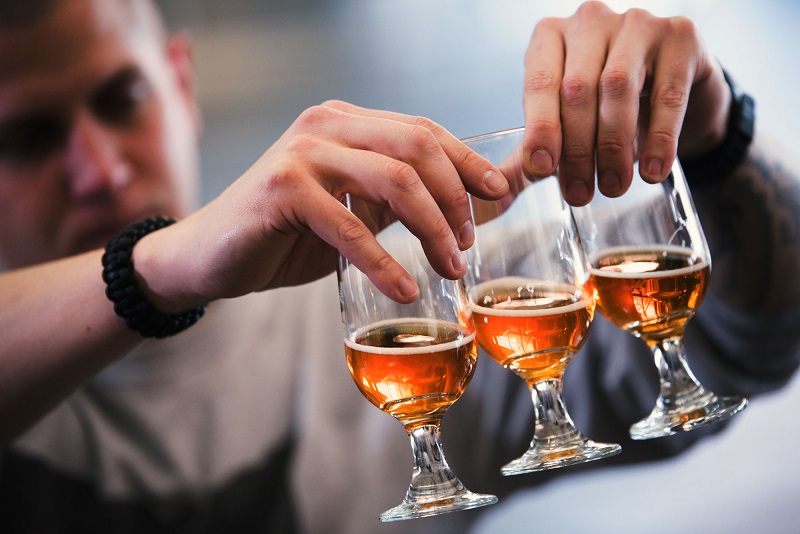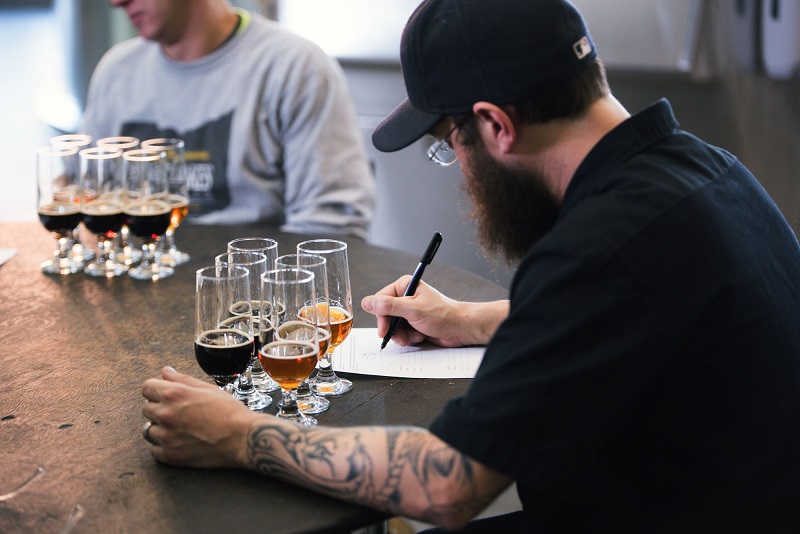Sponsored: What Really Happens in the Brewery Lab
Presented by Great Lakes Brewing Company
Craft beer lovers often misunderstand the role of the brewery room (or sometimes closet) that’s brimming with laboratory equipment. Your brewery tour guide may mention the importance of the lab and sensory tastings in producing consistent, high-quality beer, but if your tour passes the lab, it’s typically a drive-by.
“Since we are behind glass, I sometimes feel like we’re in a zoo,” says Robert Hollerorth, Great Lakes Brewing Company’s lab manager. “Tour groups might glance into the lab, but when they see all the equipment, it reminds them of the misery of high school chemistry lab, and they’re often happy to move on.”
Hollerorth dispels a common myth about what brewery labs do: “We don’t typically develop beer recipes in the lab. Research and development starts in the brewpub (see previous article on Great Lakes Brewing’s Pub Exclusives). However, the lab team does analyze new and experimental beers produced in the brewpub and figures out how to accurately scale them up for brewery production if necessary.
After 16 years at Great Lakes Brewing, 10 of those in the lab, Hollerorth has been intimately involved with adding new processes and procedures as well as state-of-the-art equipment for testing beer at every stage of its production, packaging and shelf life.
The lab crew works with every batch starting with raw ingredient analysis. That analysis doesn’t end until months after the beer is packaged. The lab follows a prescribed series of quality tests on every aspect of every brew—from ingredients to the final product.
Lab staff test every shipment of hops and malt to ensure it complies with Great Lakes Brewing’s quality standards. Then every batch of beer is assigned an identification number that grows in length as it progresses through the brewery.
“It’s like the beer’s social security number. From then on, that beer will always be known by its brew number,” Hollerorth says.
The number goes on the packaged product as well, so every bottle of beer is traceable—even after it’s sold.
As that batch of beer moves through the brewery, say it is Eliot Ness 18458 (Amber Lager), it gets its own “biography,” per Hollerorth. The lab and brewers check on the fermenting EN18458 daily. They add extensive notes to EN18458’s brew sheet, recording gravity, pH, yeast cell concentration and healthiness, and other parameters. Each batch is tasted several times before filtering and packaging. Together, the brewers and lab team write that beer’s story.
“In this facility, we’ve brewed some of our year-round beers nearly a thousand times now, and we have clear expectations for how each one behaves during the fermentation process,” Hollerorth says. “We do take corrective action if needed, although it doesn’t happen often. The bigger the brewery, typically the less variation you’ll have with your product because of tighter controls. Sometimes we need to take corrective action, and we hope to catch it early in the process.”
Everyone who works at Great Lakes can participate in the daily sensory tastings, although Hollerorth notes the most popular day of the week is “Fermenter Friday.” On that day, the sensory panel tastes beers out of the fermenters before they are filtered and packaged. The other days of the week, the panel tastes archived packaged beer. A supply of bottles from each batch is placed in dark, cold storage for its entire shelf life. Each beer is tasted on its packaging day, then re-tasted as many times as possible over the life of the beer. Previous tasting panels have determined the optimum shelf life of each beer.
Lagers typically have freshness expiration dates of 110 days, while IPAs only get 90 days. Porters and stouts have longer shelf lives. The typical rule of thumb is the hoppier the beer, the shorter its shelf life. Hops can degrade relatively quickly—even when protected from light and heat.
“IPAs have a notoriously short shelf life,” Hollerorth says. “We are especially vigilant about monitoring our kegged IPAs, which periodically undergo their own unique taste panel assessment. We even retrieve kegs from the field to accumulate additional data, ensuring that they reliably hold up through their freshness window.”
Mondays through Thursdays, the sensory panel performs blind tastings of three of the same beers—one packaged that day, one that’s in the middle of its shelf life, and one that’s at or nearing its expiration date. The panel accumulates data by assigning a numerical value to the beer’s appearance, aroma, and flavor that enables detailed statistical analysis. That data is added to the batch’s biography.
“We typically have more than 60 years of tasting experience in the room most days, even if it’s only three or four of us,” Hollerorth says. “The sensitivity of our tasting panel is so finely developed that their blind analysis is almost infallible. There could be six decades of experience tasting Dortmunder (Gold Lager). They’ve tasted so many Dorts that they can almost always tell where the beer is in its life.”
Hollerorth adds that the lab team constantly works to improve their processes by sharing information with other breweries, visiting other breweries, and utilizing the resources of educational institutes such as the Siebel Institute of Technology. Great Lakes Brewing’s most recent lab equipment purchase is a gas chromatography-mass spectrometry machine, which measures and analyzes volatile organic compounds. This enables qualitative and quantitative analysis of beer at many stages of production, similar to some of the largest breweries.





Many thanks for all of the info about the process of making great beer. Even more interesting to me since I was born & raised in Cleveland!
Very interesting and informative. Had no idea so much went into lab and taste analysis. Should be an indication of a VG brewer.